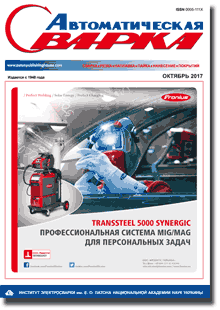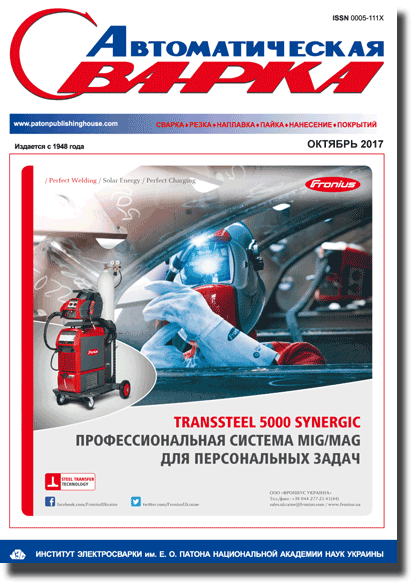| 2017 №10 (01) |
DOI of Article 10.15407/as2017.10.02 |
2017 №10 (03) |

Avtomaticheskaya Svarka (Automatic Welding), #10, 2017, pp. 17-27
Efficiency of different methods of strengthening treatment of welded joints
V.A. Degtyarev
G.S. Pisarenko Institute for Problems of Strength of the NAS of Ukraine 2 Timiryazevskaya Str., 01014, Kiev-14, Ukraine, Ukraine. Е-mail: ips@ipp.kiev.ua
Abstract
The efficiency of selection of non-damaging modes of vibration treatment of welded elements of low-carbon steel metal structures with the purpose of reducing residual stresses in them without danger of fatigue fracture at the stage of technological treatment is shown. The comparative fatigue investigations showed an increase in the service life of vibrotreated welded joints and an increase in their fatigue limit at the increase of test base. A method for determination of fatigue limits for butt welded joints of low-carbon steel after different modes of high-frequency mechanical peening, using experimental data of groove depth measurement, was proposed. The efficiency of increasing their fatigue limit is shown depending on the speed of high-frequency mechanical peening and the amplitude of oscillations of the working tool. The results of experimental investigations of increasing fatigue resistance of welded joints of low-alloy and low-carbon steels under harmonic and repeated impact loading at the temperature of –60 °C after high-frequency mechanical peening, argon-arc, explosive, and mechanical treatments were analyzed and a comparative analysis of their efficiency was presented. 23 Ref., 4 Tables, 10 Figures.
Keywords: welded joint, fatigue resistance, fatigue limit, residual stresses, depth of groove, speed of peening
Received: 26.10.17
Published: 13.11.17
References
- A.E., Ivashchenko, G.A. (1978) Increase in strength of welded structures. Kiev, Naukova Dumka [in Russian].
- Kudryavtsev, I.V., Naumchenkov, N.E. (1976) Fatigue of welded structures. Moscow, Mashinostroenie [in Russian].
- Trufyakov, V.I. (1973) Fatigue of welded joints. Kiev, Naukova Dumka [in Russian].
- Dreger, D.R. (1978) Good vibes reduce stresses in metal parts. Machine Design, 50(13), 100–103.
- Ting, W., Dongpo, W., Lixing, H., Yufend, Z. (2008) Discussion on fatigue design of welded joints enhanced by ultrasonic peening treatment (UPT). International J. of Fatigue, 3, 1–7.
- Shpeer, F.Z., Panov, V.I. (1983) Vibration treatment of large-sized welded structures to decrease the strains and crack formation susceptibility. Proizvodstvo, 5, 13–15.
- Thompson, L. (1969) A method of removing stresses in components by vibration and a setup for this purpose. UK Pat. 1259556 [in Russian].
- Zimnitsky, Yu.A., Khvalynsky, V.N. (2004) Experimental verification of influence of low-frequency vibration treatment on service reliability of hull structures. Sudostroenie, 1, 50–52 [in Russian].
- Xiaohui, Z., Dongpo, W., Lixing, H. (2011) Analysis of the S-N curves of welded joints enhanced by ultrasonic peening treatment. Materials & Design, 32, 88–96. https://doi.org/10.1016/j.matdes.2010.06.030
- Mikheev, P.P., Nedoseka, A.Ya., Parkhomenko, I.V. et al. (1984) Efficiency of application of ultrasonic peening treatment for improvement of fatigue resistance of welded joints. Svarka, 3, 4–7 [in Russian].
- Lobanov, L.M., Kirian, V.I., Knysh, V.V. et al. (2006) Improvement of fatigue resistance of welded joints in metal structures by high-frequency mechanical peening (Review). The Paton Welding J., 9, 2–8 [in Russian].
- Degtyarev, V.A. (2011) Evaluation of effect of high-frequency mechanical peening modes of welded joints on their fatigue resistance. Problemy Prochnosti, 2, 61–70 [in Russian].
- Grishakov, S.V., Kovalev, A.M. (1988) Application of Barkhausen effect for evaluation of stresses and damages in ferromagnetic materials. Kiev, IPS [in Russian].
- Degtyarev, V.A. (1982) Units of DSO type for fatigue tests under impact reloading with different cycle asymmetry. Problemy Prochnosti, 10, 110–113 [in Russian].
- Statnikov, E.Sh., Shevtsov, E.M., Kulikov, V.F. (1977) Ultrasonic peening instrument for strengthening of welds and reducing the residual stresses. In: New physical methods of intensification of technological processes. Moscow, Metallurgiya, 27–29 [in Russian].
- Prokopenko, G.I., Kleiman Ya.I., Kozlov, O.V. et al. Device for ultrasonic peening treatment of metals. Ukraine Pat. 47536, Publ. 15.07.2002 [in Ukrainian].
- Degtyarev, V.A. (1991) Influence of coefficient of cycle stress asymmetry on fatigue and cyclic creep of low-alloyed steels. Rep. 2. Problemy Prochnosti, 2, 27–31 [in Russian].
- Visilovsky, N.G., Pozhidaev, N.G., Demin, V.M. (1992) Problems of application of vibration treatment instead of heat treatment. Tyazholoe Mashinostroenie, 8, 20–22 [in Russian].
- Marguis, G. (2010) Failure modes and fatigue strength of improved HSS welds. Engineering Fracture Mechanics, 77, 2051–2062. https://doi.org/10.1016/j.engfracmech.2010.03.034
- Serensen, S.V., Kogaev, V.P., Shnejderovich, R.M. (1975) Load-carrying capacity and strength calculations of machine parts. Moscow, Mashinostroenie [in Russian].
- Kirian, V.I., Knysh, V.V. (2008) High-frequency mechanical peening of welded joints of metal structures. Proizvodstvo, 11, 36–41 [in Russian].
- Shulginov, B.S., Degtyarev, V.A., Matveev, V.V. (1984) On ultimate cycle stresses of welded joints with high residual stresses. Problemy Prochnosti, 3, 58–61 [in Russian].
- Shulginov, B.S., Matveev, V.V., Degtyarev, V.A. (1985) About influence of microdefects in welds on fatigue resistance of metal structures of mining and transport technics. In: of 2nd Republ. Conf. on Improvement of Reliability and Service Life of Machines and Constructions. Kiev, Naukova Dumka, 167–168.
The cost of subscription/purchase order journals or individual articles
| Journal/Currency | Annual Set | 1 issue printed |
1 issue |
one article |
| TPWJ/USD | 384 $ | 32 $ | 26 $ | 13 $ |
| TPWJ/EUR | 348 € | 29 € | 24 € | 12 € |
| TPWJ/UAH | 7200 UAH | 600 UAH | 600 UAH | 280 UAH |
| AS/UAH | 1800 UAH | 300 UAH | 300 UAH | 150 UAH |
| AS/USD | 192 $ | 32 $ | 26 $ | 13 $ |
| AS/EUR | 180 € | 30 € | 25 € | 12 € |
| SEM/UAH | 1200 UAH | 300 UAH | 300 UAH | 150 UAH |
| SEM/USD | 128 $ | 32 $ | 26 $ | 13 $ |
| SEM/EUR | 120 € | 30 € | 25 € | 12 € |
| TDNK/UAH | 1200 UAH | 300 UAH | 300 UAH | 150 UAH |
| TDNK/USD | 128 $ | 32 $ | 26 $ | 13 $ |
| TDNK/EUR | 120 € | 30 € | 25 € | 15 € |
AS = «Automatic Welding» - 6 issues per year;
TPWJ = «PATON WELDING JOURNAL» - 12 issues per year;
SEM = «Electrometallurgy Today» - 4 issues per year;
TDNK = «Technical Diagnostics and Non-Destructive Testing» - 4 issues per year.





